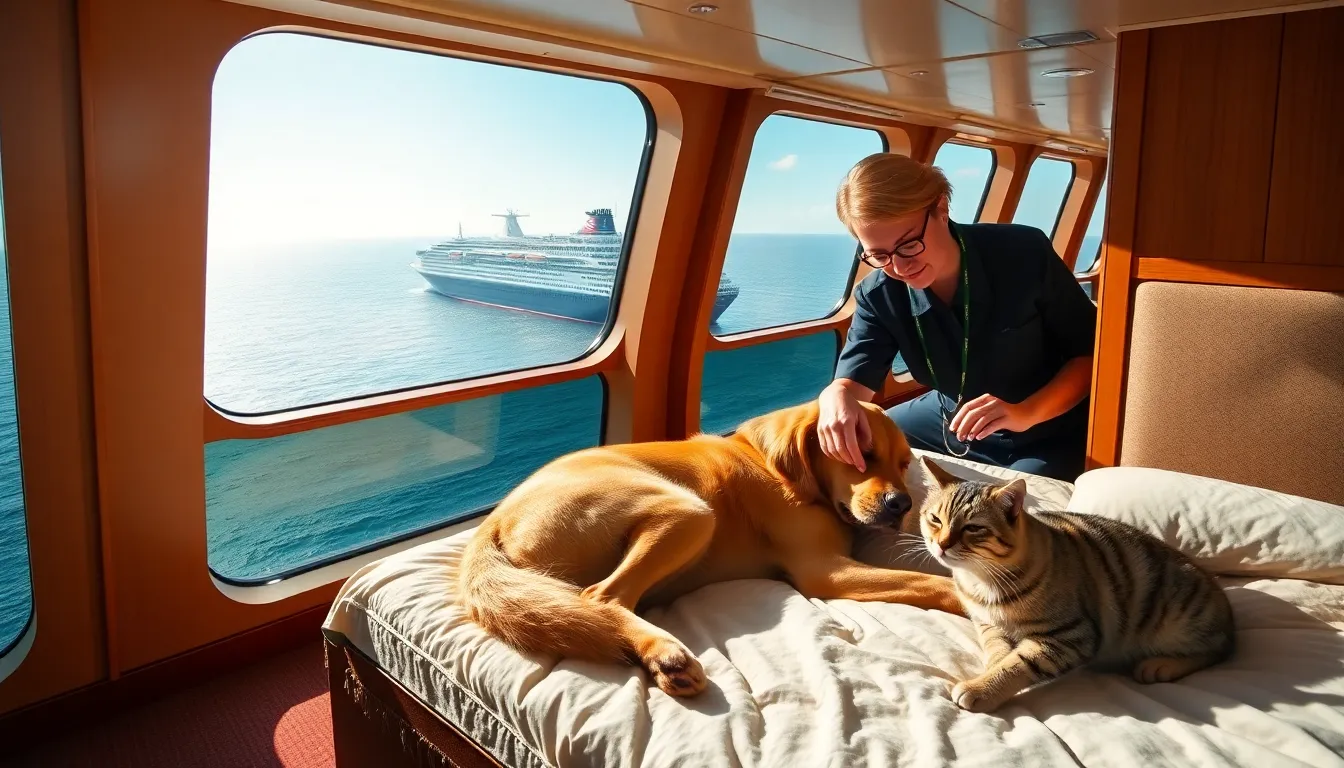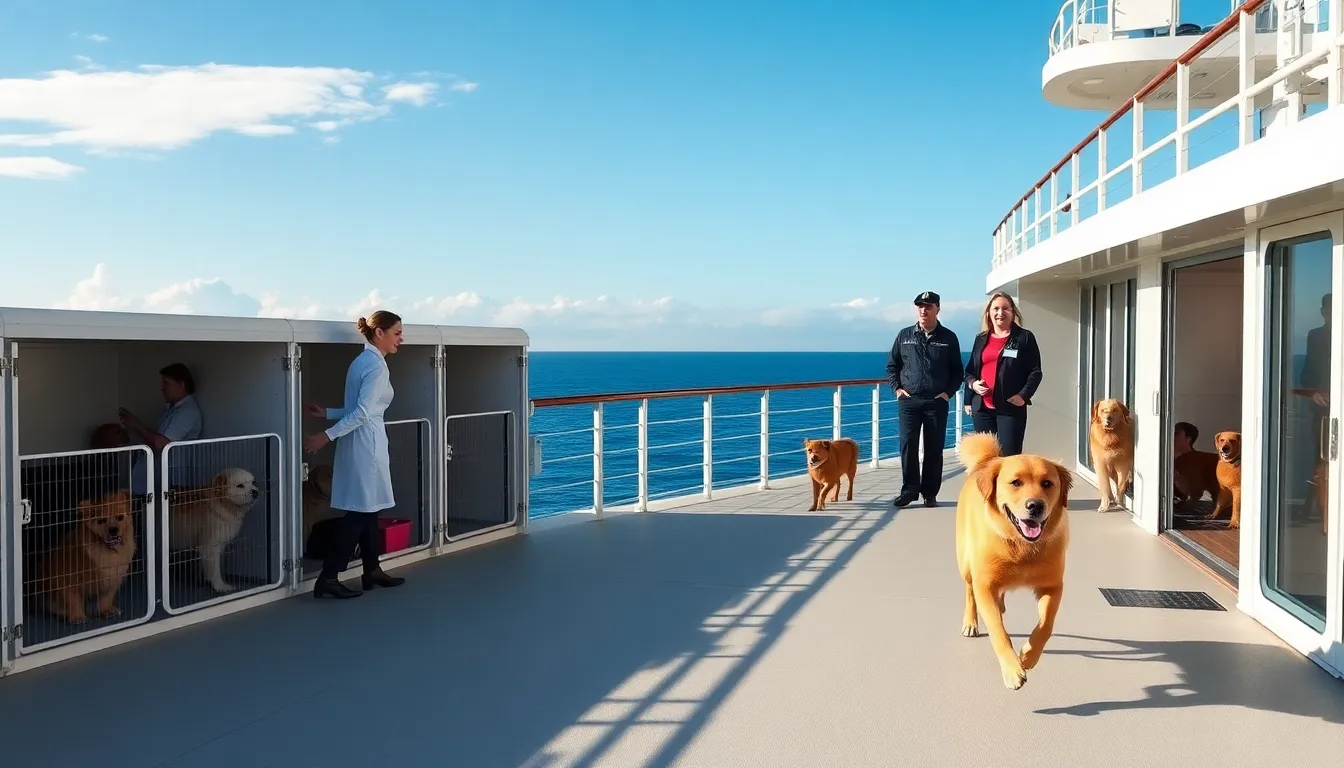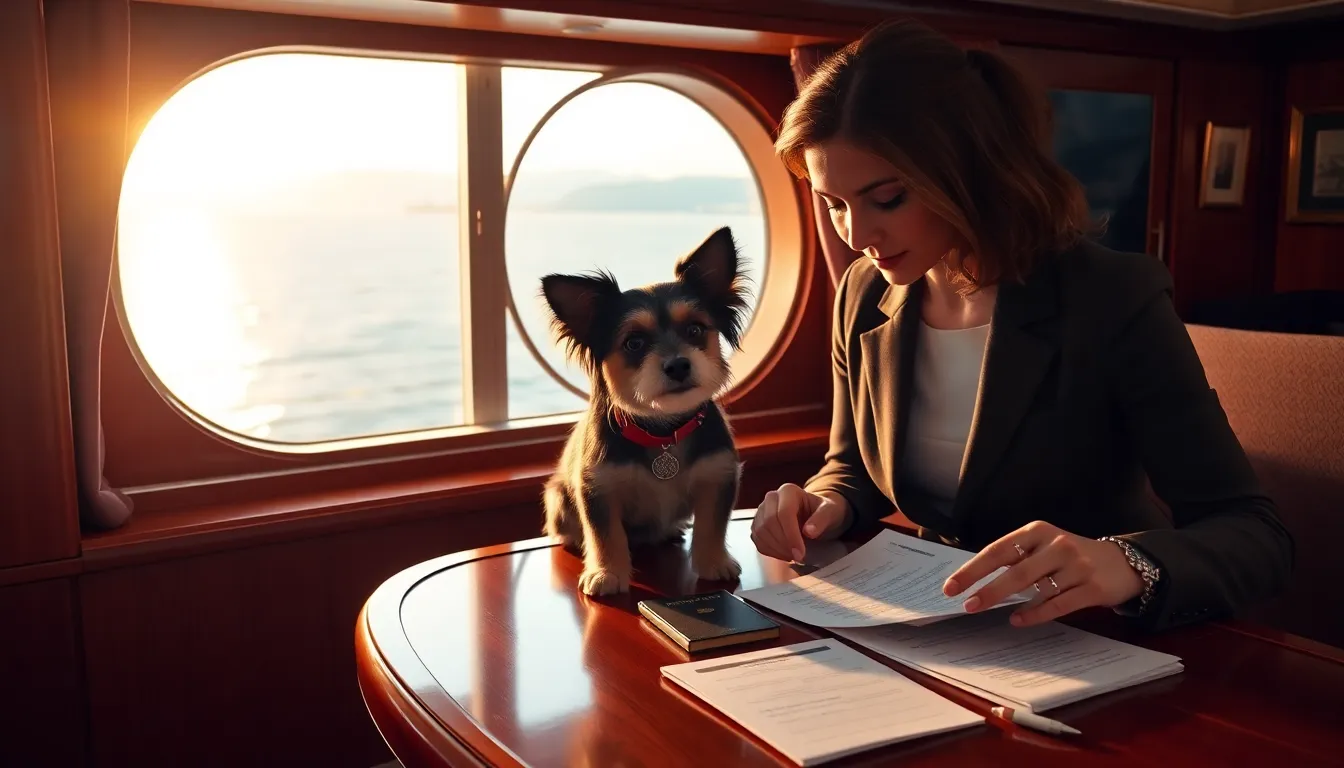The Low-Stress Transportation Method That May Unexpectedly Be Better For Moving To A Different Country With A Pet refers to Cunard’s Queen Mary 2, which offers a unique ocean liner service specifically designed for international pet relocation, providing a distinct alternative to traditional air cargo. This exclusive service prioritizes animal well-being by directly mitigating severe risks associated with air travel, offering professional care, and allowing extensive owner interaction throughout the transatlantic voyage.
- Pet safety and well-being are significantly enhanced by Queen Mary 2’s exclusive service, which offers a stable, supervised environment with professional kennel masters and allows frequent owner interaction, directly avoiding critical risks like oxygen deprivation and overheating documented in air cargo.
- Relocation planning demands a substantial financial and time investment, with costs exceeding $3,000 (often including the owner’s fare) and requiring over a year of advance booking due to limited kennel availability.
- Pet eligibility involves strict breed restrictions and mandates a valid pet passport, crucially requiring pets to be in excellent health as no veterinary services are available on board during the 7-9 day transatlantic journey.

Queen Mary 2’s Exclusive Ocean Travel Mitigates Air Cargo Risks for Pet Relocation
For pet owners navigating the complexities of international relocation, finding a reliable and humane transportation method is paramount. Cunard’s Queen Mary 2 stands alone as the sole ocean liner service specifically for pets, offering a unique transatlantic solution. This service provides a distinct alternative to traditional air cargo, actively reducing serious risks documented in air travel such as oxygen deprivation or overheating. It represents The Low-Stress Transportation Method That May Unexpectedly Be Better For Moving To A Different Country With A Pet.
Unparalleled Pet Travel: Cunard’s Queen Mary 2 Service
The exclusive nature of this offering cannot be overstated. Only Cunard provides this specialized pet travel service, and it is available solely on their flagship vessel, the Queen Mary 2. This dedicated service caters specifically to dogs and cats, ensuring they receive attentive care throughout the voyage. For many, this makes the Queen Mary 2 the only viable choice for a truly pet-friendly international move.
Pet owners benefit from two distinct pet-friendly routes for their transatlantic crossings. These journeys depart from New York’s Brooklyn Cruise Terminal, with destinations including Southampton, England, or Hamburg, Germany. The service operates in both directions, offering convenient options for individuals moving to Europe or returning to the United States. This direct transatlantic link simplifies what can otherwise be an arduous process.
A journey across the Atlantic aboard the Queen Mary 2 typically spans seven or nine days. This extended, deliberate transit provides a stark contrast to the often-shorter but potentially riskier air travel cargo options. The duration allows for a more stable and controlled environment, significantly contributing to the well-being of animal companions throughout their international journey.
Avoiding the Perils of Air Cargo for Pet Relocation
The primary advantage of the Queen Mary 2’s service lies in its ability to directly mitigate severe risks associated with traditional air cargo. Air travel, particularly when pets are transported in cargo holds, has unfortunately been linked to tragic incidents. There have been “several cases of pets dying…due to reasons ranging from a lack of oxygen to overheating” documented in air cargo environments.
These documented fatalities highlight the critical need for safer, more controlled alternatives. Pets traveling in aircraft cargo compartments can be exposed to extreme temperatures or insufficient oxygen levels. Such conditions create highly stressful, uncomfortable, and often life-threatening environments for animals. The Queen Mary 2’s dedicated kennels and onboard staff directly address these concerns, offering a supervised and climate-controlled setting.
Opting for ocean travel means pets can completely avoid the cargo hold risks associated with air travel. This specifically includes the environmental conditions that have tragically led to fatalities. For families making the crucial decision of The Low-Stress Transportation Method That May Unexpectedly Be Better For Moving To A Different Country With A Pet, this peace of mind is an invaluable benefit.
The Queen Mary 2 routes are ideally positioned for individuals either moving to or planning extended vacations in Europe. They offer a direct transatlantic link that explicitly prioritizes pet safety and comfort. This approach ensures the transatlantic journey becomes part of a positive experience, rather than a significant source of anxiety for pet owners.
This service presents a specific and humane alternative to traditional air cargo methods for international pet relocation. It allows pets to travel in a closely monitored and attended environment, significantly reducing stress for both the animals and their owners. This focus on animal welfare defines The Low-Stress Transportation Method That May Unexpectedly Be Better For Moving To A Different Country With A Pet.
Cunard’s Queen Mary 2 offers a unique and thoughtful solution for pet owners relocating internationally with their dogs and cats. It transforms a potentially traumatic experience into a more relaxed and secure one for beloved animal companions. The ability to avoid severe environmental risks, a known danger in air cargo, positions this method as an unexpectedly superior choice for transatlantic pet travel.

Daily Owner Access and Professional Kennel Masters Ensure Pet Well-being During Ocean Voyages
Moving to a different country with a pet presents significant logistical and emotional challenges, often highlighting the need for The Low-Stress Transportation Method That May Unexpectedly Be Better For Moving To A Different Country With A Pet. Traditional methods, particularly air cargo, can be highly stressful for animals and owners alike due to limited interaction and uncertain conditions. The Queen Mary 2, however, offers a unique and highly structured approach to pet travel, prioritizing animal welfare through dedicated facilities, professional oversight, and crucial owner access, providing significant peace of mind.
Pets embarking on a transatlantic voyage aboard the Queen Mary 2 are not simply transported; they are accommodated in dedicated, “roomy kennels” for the duration of the journey. These facilities are designed to provide a comfortable and secure environment, recognizing that a pet’s temporary home at sea plays a vital role in their overall well-being. This specialized environment ensures that pets have a designated space that caters to their needs, minimizing the disruptions often associated with long-distance travel.
Integral to this exceptional level of care are the professional kennel masters onboard. These dedicated individuals are responsible for looking after pets, performing duties that extend beyond basic feeding and cleaning. They continuously monitor the animals, ensuring their safety, comfort, and emotional stability throughout the voyage. Their expert supervision is a cornerstone of the Queen Mary 2’s pet program, providing a consistent and knowledgeable presence for every animal passenger.
Unparalleled Owner Interaction During Ocean Crossings
A distinguishing feature of pet travel on the Queen Mary 2 is the robust system for owner visitation. Unlike typical air cargo scenarios where access to pets is severely restricted or non-existent, Queen Mary 2 offers specific, generous visitation windows. Owners can visit their pets “about 4/5 times a day” during designated hours, with individual visits reportedly lasting “anywhere from 30mins to 2 hours” based on a Reddit user’s experience. This frequent and lengthy interaction significantly reduces stress for both pets and their owners.
The ability to spend quality time with pets multiple times a day is a critical factor in maintaining their emotional well-being during such a significant life change. These regular interactions help to uphold routines, reinforce the bond between pet and owner, and provide tangible reassurance that their beloved companion is safe and cared for. This direct and frequent owner interaction stands in stark contrast to the limited or no access typically available during air cargo transport, a key advantage making Queen Mary 2 The Low-Stress Transportation Method That May Unexpectedly Be Better For Moving To A Different Country With A Pet.
Real-World Experiences: A Glimpse into Life Aboard
The tangible benefits of this structured care and access system are best illustrated through real-world examples. The documented experience of Joyce Chan and her golden retriever Charlie on TikTok provides a heartwarming testament to the pet-friendly environment onboard. Videos captured Charlie happily running around the deck, clearly enjoying the open space and fresh sea air, a stark difference from the confined spaces pets often endure during long-haul travel.
Charlie’s journey also showcased the social aspect of pet travel on the Queen Mary 2, as he was observed meeting fellow pup passengers. This opportunity for socialization with other animals, within a controlled and safe environment, contributes positively to a pet’s mental stimulation and overall happiness. The sight of pets thriving and interacting freely on deck underscores the unique, integrated experience offered, ensuring that their well-being is prioritized at every stage of the journey.
Facilitating Adjustment: The Proactive Role of Kennel Masters
Beyond daily care and visitation, the Queen Mary 2’s approach extends to proactive measures designed to ease a pet’s transition. A notable detail from Charlie’s experience was that kennel masters reportedly met him before boarding. This pre-boarding engagement is a thoughtful and effective strategy to facilitate a pet’s adjustment to temporary caregivers and new surroundings. Meeting the kennel masters beforehand allows pets to become somewhat familiar with the individuals who will be looking after them, reducing anxiety upon embarkation.
This personalized touch highlights the deep understanding of animal psychology held by the staff. By establishing a preliminary connection, the temporary caregivers can better understand a pet’s temperament and needs, ensuring a smoother adjustment period into their temporary accommodations. Such proactive measures are invaluable in minimizing stress, contributing significantly to a successful and peaceful relocation for animals and reinforcing Queen Mary 2’s position as a truly pet-centric travel option.
The comprehensive pet program on Queen Mary 2, with its dedicated facilities, continuous oversight by professional kennel masters, and generous owner visitation, offers a holistic approach to pet well-being during ocean voyages. This meticulous attention to care and comfort ensures pets are not just transported, but genuinely cared for, making it an unexpectedly superior and genuinely low-stress method for relocating with pets to a different country.

Over $3,000 Cost and Year-Plus Planning Required for Transatlantic Pet Passage
For those considering moving to a different country with a pet, particularly via ocean liner, the Queen Mary 2 presents itself as The Low-Stress Transportation Method That May Unexpectedly Be Better For Moving To A Different Country With A Pet. However, securing a pet’s spot on this luxurious vessel demands a significant financial investment and extensive advance planning. Documented cases highlight costs exceeding $3,000, often including the owner’s fare, necessitating preparations typically spanning over a year due to limited availability and strict breed restrictions. This unique mode of transport, while potentially calmer for animals than air travel, comes with specific practical and financial implications that prospective travelers must understand well in advance.
The financial outlay for pet passage on the Queen Mary 2 is substantial. Joyce Chan, for instance, reported that her trip to Southampton with her dog Charlie in May 2025 cost “over $3,000.” Notably, this fee her fare included, making it a comprehensive package rather than just a pet-specific charge. This bundled cost is a critical detail, as it means the pet’s journey is intrinsically linked to the owner’s, adding to the overall expense but also simplifying some aspects of the booking process. Such a significant investment underscores the premium nature of this pet relocation service.
Beyond the financial commitment, the planning horizon for ocean liner pet travel is exceptionally long. Booking and meticulously planning a Queen Mary 2 cruise for a pet “can take more than a year” due to the very limited space available in the on-board kennels. This extended lead time differs markedly from typical airline pet policies, which often have shorter booking windows, albeit with their own set of challenges. Passengers must factor in this lengthy preparation period to secure a highly coveted spot for their animal companion, making spontaneous travel impossible.
Furthermore, not all dogs are permitted aboard the Queen Mary 2. The cruise line enforces specific breed restrictions, explicitly prohibiting “larger breeds such as Dobermans, pit bull terriers, mastiffs, and others.” This policy is crucial for owners of larger or restricted breeds, as it immediately disqualifies them from considering this option. Owners must confirm their pet’s eligibility long before any financial commitments are made. These breed and size restrictions, coupled with the long booking horizon, underscore the distinct operational differences when compared to standard airline pet travel regulations.
A mandatory requirement for all pets traveling on the Queen Mary 2 is a valid pet passport. This essential document certifies that the animal meets all health and vaccination requirements for international travel, aligning with the destination country’s import regulations. Ensuring all necessary vaccinations and health checks are current and properly documented in the pet passport is a critical step in the extensive planning process, reinforcing the need for expert veterinary consultation well in advance of departure.
One of the most critical limitations of choosing this method for relocating pets internationally by sea is the complete absence of on-board veterinary services. No veterinary services are available on board for pets with health issues, highlighting a significant risk factor. Owners are solely responsible for their pet’s health and well-being during the transatlantic voyage. This means any pet with pre-existing conditions or those prone to motion sickness requires careful consideration and preparation, as immediate professional medical intervention would not be accessible if a health issue arises mid-journey.
This lack of veterinary support differentiates Queen Mary 2 travel from some airline options that might offer more immediate, albeit limited, veterinary consultation resources at major hubs. While the tranquil nature of sea travel might appeal to some pet owners seeking a low-stress pet transportation experience, the absence of on-board medical staff for animals underscores the necessity for pets to be in excellent health prior to embarkation. Pet owners must meticulously plan for all potential health contingencies, including bringing any necessary medications or comfort items for their animals, to ensure a smooth journey.
In conclusion, while the Queen Mary 2 offers a unique and potentially less stressful transit for pets moving to a new country, the financial investment, extensive year-plus planning, breed restrictions, and critical lack of veterinary services on board necessitate thorough preparation. This mode of pet travel is not for everyone and demands a deep understanding of its specific requirements and limitations.
Featured image generated using Flux AI
Islands: “The Low-Stress Transportation Method That May Unexpectedly Be Better For Moving To A Different Country With A Pet”
